Most Popular Bird Dog Breeds of 2025
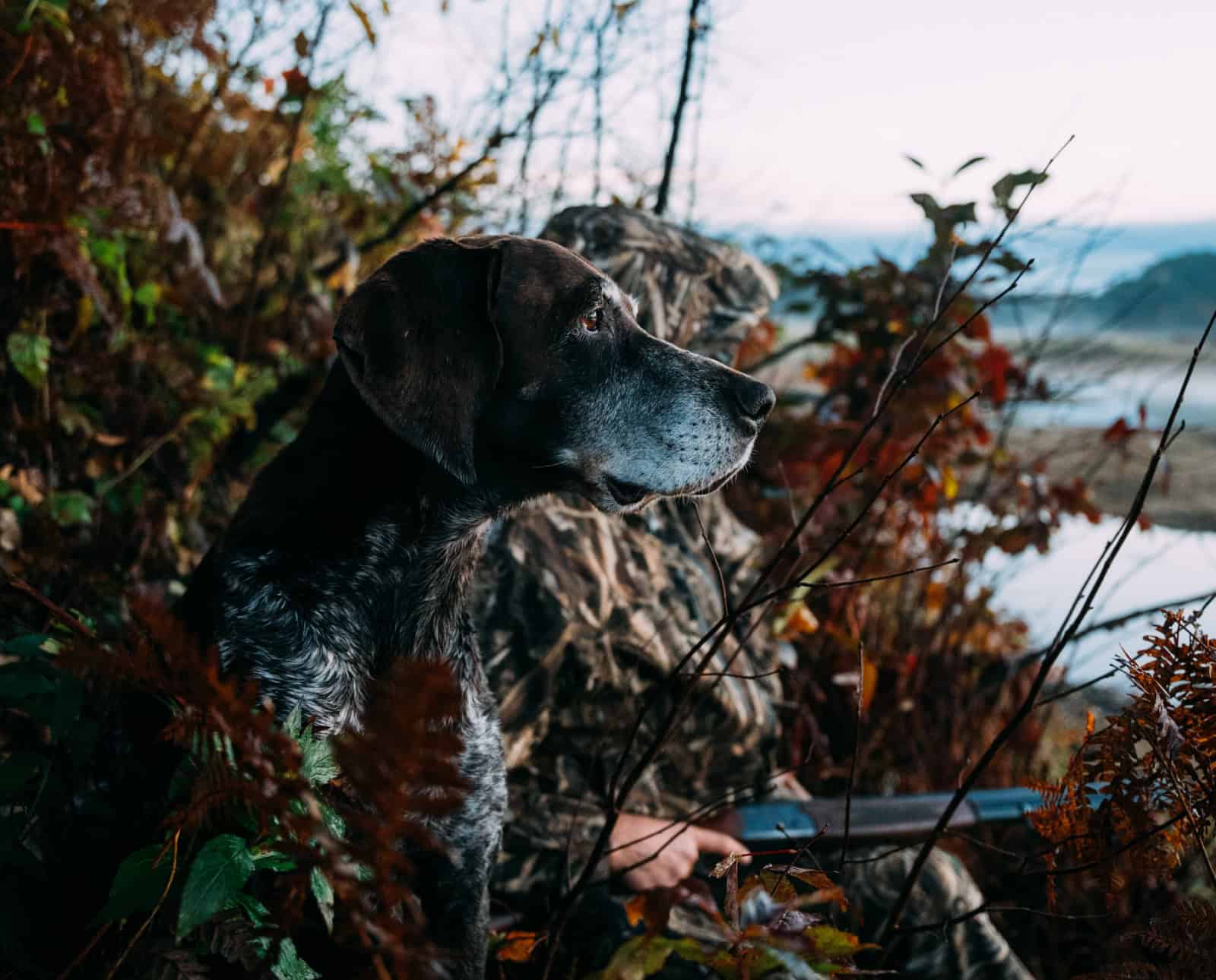
Exploring the most popular bird dog breeds of the upland hunting community over the years.
Every spring, Project Upland conducts its annual North American Upland Bird Hunting Survey. To no one’s surprise, in the survey, we ask a bunch of questions about dogs. Seventeen questions, to be exact. Our goal is to learn about how many dogs you have, what breeds you own, the type of hunting dogs you prefer, and the impact that dogs have had on you as a hunter. However, an added bonus of the survey is that it captures which dog breeds are the most popular within the Project Upland community.
We also enjoy sharing the survey’s data with you. And of course, since we’re all dog lovers here, there’s an argument to be made that the most interesting information found in the survey is the top 5 most popular bird dog breeds.
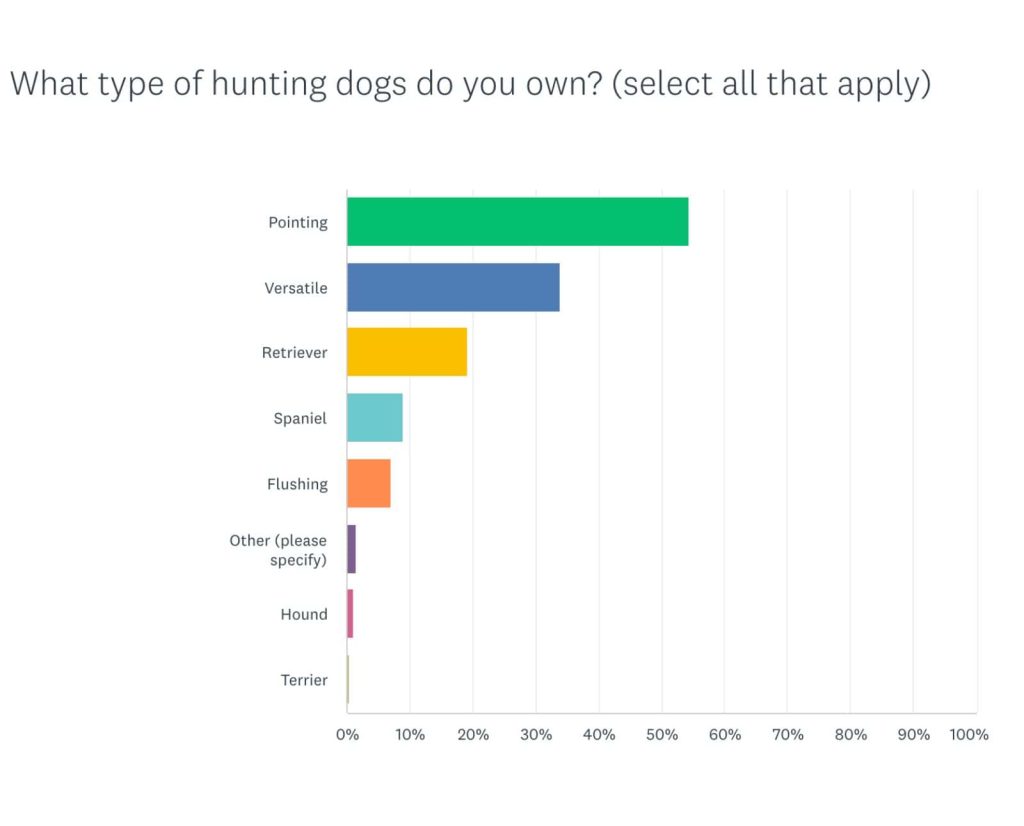
The Most Popular Types Of Hunting Dogs
The hunting dog world is full of personal biases, and our survey results reflected our community’s diverse preferences. When asked, “What type of hunting dogs do you own? Select all that apply,” you answered:
- Pointing, 54%
- Versatile, 34%
- Retriever, 19%
- Spaniel, 9%
- Flushing, 7%
- Other, 2%
- Hound, 1%
- Terrier, 0.4%
Pointing dogs have retained the #1 spot for eight years in a row. Versatile dogs are up one percent from 2024, and spaniels are up two percent. The other types of hunting dogs hasn’t changed over the last year. We won’t let our dog breed snobbery enter the chat, but personally, we’re always happy to see pointing and versatile dogs in the number one and two spots, respectively.
In addition to asking about what type of hunting dog the Project Upland community owns, we also asked how many bird dogs you own.
How Many Bird Dogs Do You Own?
Much like how it’s nearly impossible to eat just one potato chip, it’s hard to own only one bird dog. While 50 percent of respondents own one bird dog, 34 percent own two, 10 percent own three, and six percent own four or more bird dogs.
The survey also asked which breeds of dogs you own. Here’s a breakdown of the top five hunting dog breeds owned by the Project Upland community.
Top 5 Bird Dog Breeds of 2025
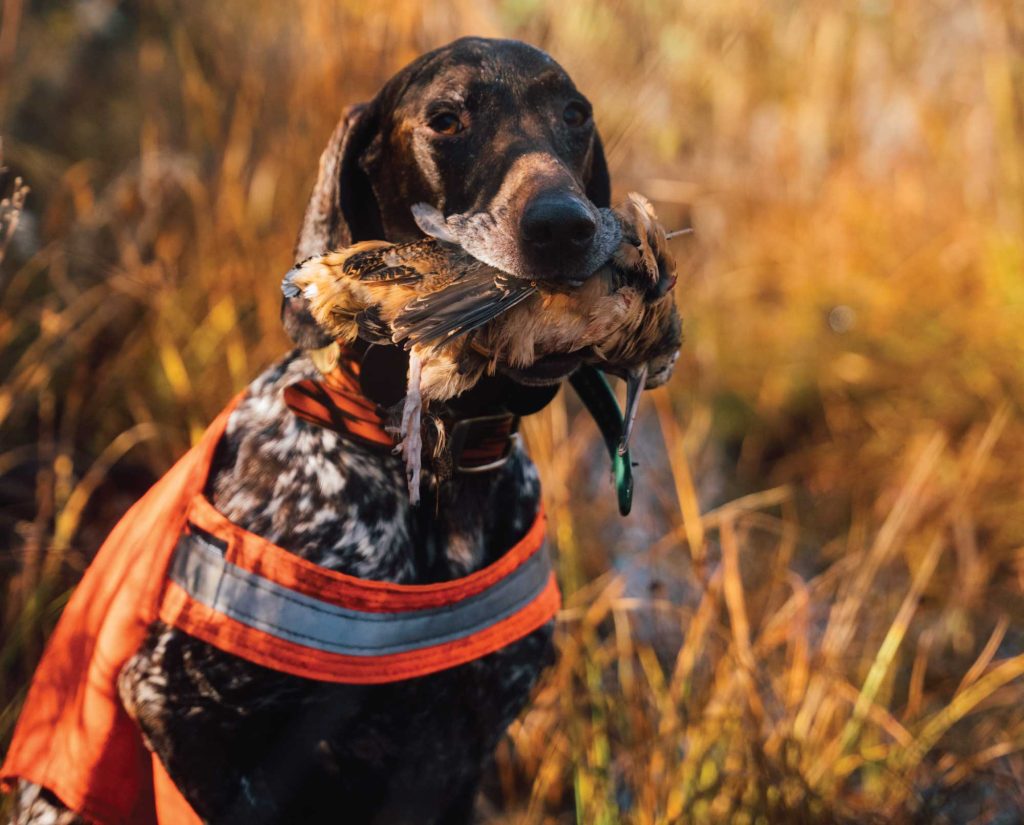
1. German Shorthaired Pointer (or Deutsch Kurzhaar): 20%
Our annual survey showed that 20% of the Project Upland Community hunts with a German Shorthaired Pointer or Deutsch Kurzhaar. That’s nearly one-fifth of our entire community. Although it’s one percent less than what the GSP polled in 2023, it’s almost exactly the same as what we recorded in 2024.
The North American Versatile Hunting Dog Association registered 1,487 GSPs in 2022, making it NAVHDA’s most popular dog. However, they’ve seen a slight downward trend in GSPs from the breed’s 2021 peak.
The GSP is also the only pointing dog to appear in American Kennel Club’s top 10 most popular dog breeds. The AKC creates this list based on its registration statistics. The GSP was the tenth most popular breed in 2023 and 2025, but in 2025, it’s moved up to number nine.
German Shorthairs are the most popular among Gen Z. In fact, a staggering 53 percent of folks born after 1996 have a GSP in their home. 21 percent of Generation X, or folks born between 1965 and 1980 have one. 20 percent of Millennials, or folks born between 1981 and 1996, are GSP owners. GSPs are the least popular breed among Baby Boomers. Only 17 percent of people born before 1965 reported owning one.
Most hunters use their GSPs to pin pheasants (78%), ruffed grouse (44%), American woodcock (36%), bobwhite quail (36%), and doves (33%). Only one person used their GSP to hunt ptarmigan, and three people hunted sooty grouse with their GSP last season.
Many GSP owners are first-generation hunters; 29 percent of owners said that neither one of their parents were hunters. To no one’s surprise, 100 percent of GSP owners said they hunt birds.
Fun fact: half of GSP owners are members of Pheasants Forever.
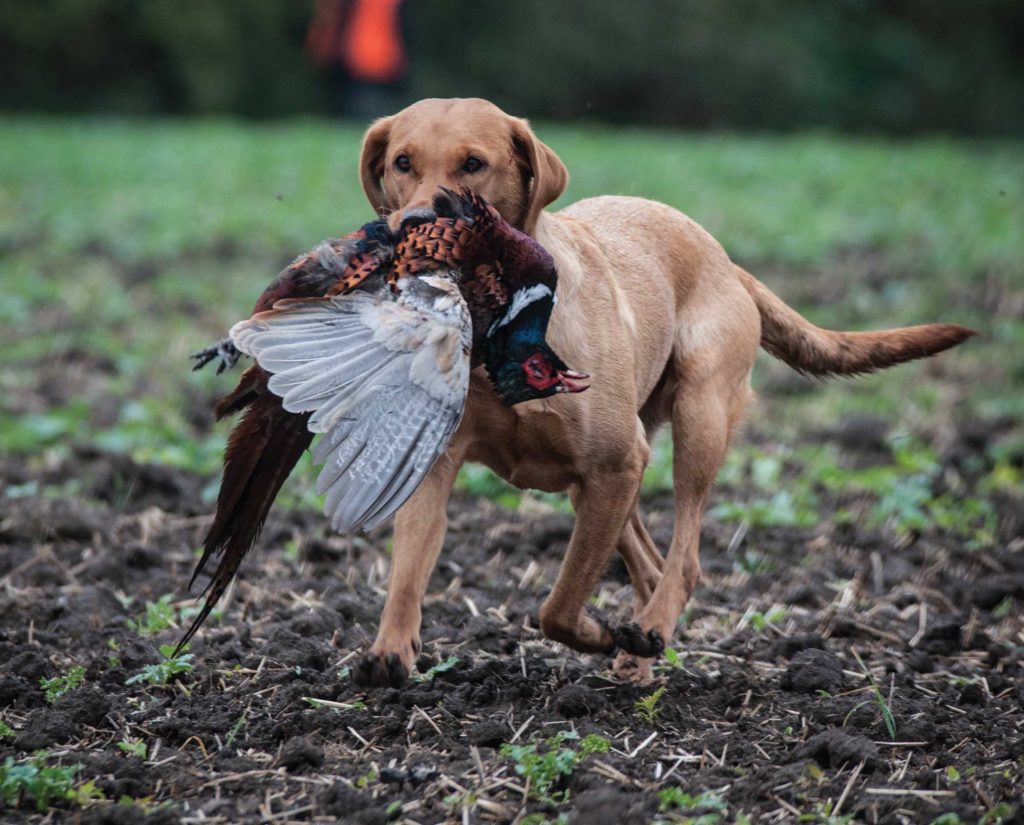
2. Labrador Retriever: 16%
The 2025 North American Upland Hunting Survey showed that the Labrador Retriever, at 16 percent, is the second most popular bird dog breed among the Project Upland community. This comes as no surprise to us because waterfowl and pheasant hunting hold special places in American hunters’ hearts. In fact, 79 percent of Labrador owners reported hunting pheasants in the fall of 2024. Similarly, 60 percent of Lab lovers also hunted waterfowl last year.
Labradors are most popular among Baby Boomers. 42 percent of them are Lab owners. 30 percent of Lab owners are Gen Xers, and 23 percent are Millennials. Gen Zers are the least Lab-loving generation; only 4 percent of them have a Lab lounging on their sofa right now.
The breed’s mainstream popularity has created a few breeding issues. There tends to be controversy surrounding the purity and standards of Labs inside the hunting community. Just utter “silver Lab” inside a room full of Labrador enthusiasts, and you’ll see what we mean.
In more recent years, there has been a surge in British Labs in America. A driving factor of this trend is the distinguishable difference in temperament between British Labs and classic, American-bred Labrador Retrievers. The iconic breed even found its way into the heart of Eddie Bauer, who wrote of the British Labrador Retriever, “The greatest of all the great dogs I have ever known; one I have loved above all others. I hope, when I go to the Happy Hunting Grounds, Blackie will come to my side, as I will try to go to his.”
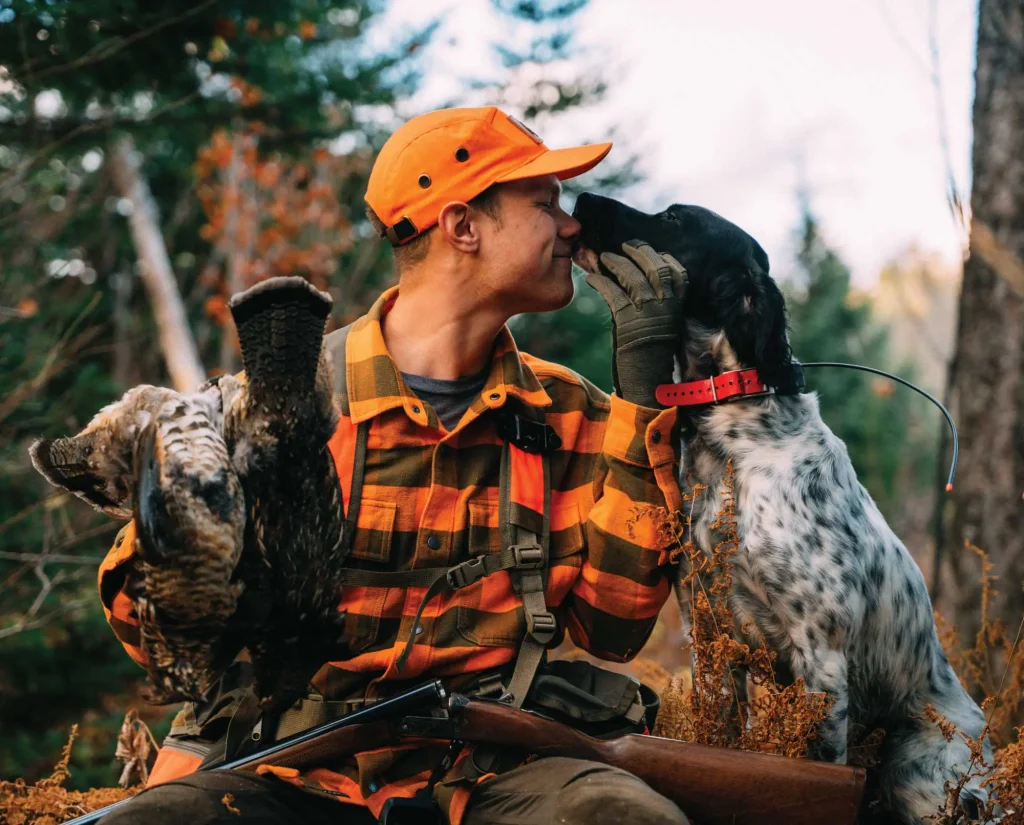
3. English Setter: 15%
The English Setter is holding tight at #3 for the third year in a row. This breed is most popular among Baby Boomers. At 19 percent, nearly one-fifth of them have a Setter at home. Millennials come in third at 14 percent, and Gen X is not far behind at 10 percent. Sadly, only 3 percent of Gen Zers own an English Setter.
Unsurprisingly, 67 percent of English Setter owners hunt ruffed grouse. 70 percent chase pheasant, and 48 percent hunt American Woodcock. For the second year in a row, only one person reported hunting ptarmigan with an English Setter. If you’re looking for a novel pursuit this hunting season, it’s time to tow your Setter out to ptarmigan country.
The English Setter just barely made the cut for the top 100 most popular dog breeds in the United States, according to the AKC, coming in at 93. However, that’s four positions higher than it was last year. The Irish Setter continues to beat them in popularity and landed 85th place in 2024, which is down from 73rd in 2023. Comparatively, the Gordon Setter was the 109th most popular dog. In our community, Irish Setters ranked 17th and Gordon Setters claimed 15th place.
Between its orginiations in England and the breed’s expansion throughout the US and beyond, the history of the Setter is fascinating. Craig Koshyk hashed it out in remarkable detail in his book, Pointing Dogs, Volume Two: The British and Irish Breeds. You can also read about Edward Laverack, listen to his 1872 book The Setter, learn about Ryman Setters, and explore just how English the English Setter is here on Project Upland.

4. Brittany: 13%
Brittanies were the 4th most popular breed within the Project Upland Community. They’re a favorite among Gen Z, of which 22 percent own at least one. 15 percent of Boomers have one. They’re third-most popular with Millennials; 10 percent of them hunt over a Brittany. Only nine percent of Gen Xers have a Brittany.
The majority of Brittany owners (42%) hunted more than 30 days last season. 77 percent of folks hunting over a Brittany chase pheasants, and 48 percent of them hunt ruffed grouse. No one reported hunting Himalayan Snowcock with a Brittany during last hunting season; 2025 is the year for one of you in our community to claim that title.
In 2024, the Brittany was the 31st most popular breed in the US, according to the AKC. According to NAVHDA, the Brittany was the 8th most popular breed registered in 2022. Overall, they continue to be a popular pointing dog breed among upland hunters and field trialers.
The history of the Brittany in the United States began in the 1930s when a well-known Wirehaired Pointing Griffon breeder began importing them. Two clubs merged in 1942 to create the American Brittany Club. By the 1960s, it was France’s most popular hunting dog breed. By the 1980s, growing pressure existed to split the Brittany into the American Brittany and French Brittany (or Epagneul Breton). The split became a reality in 2002 when the United Kennel Club officially recognized it.
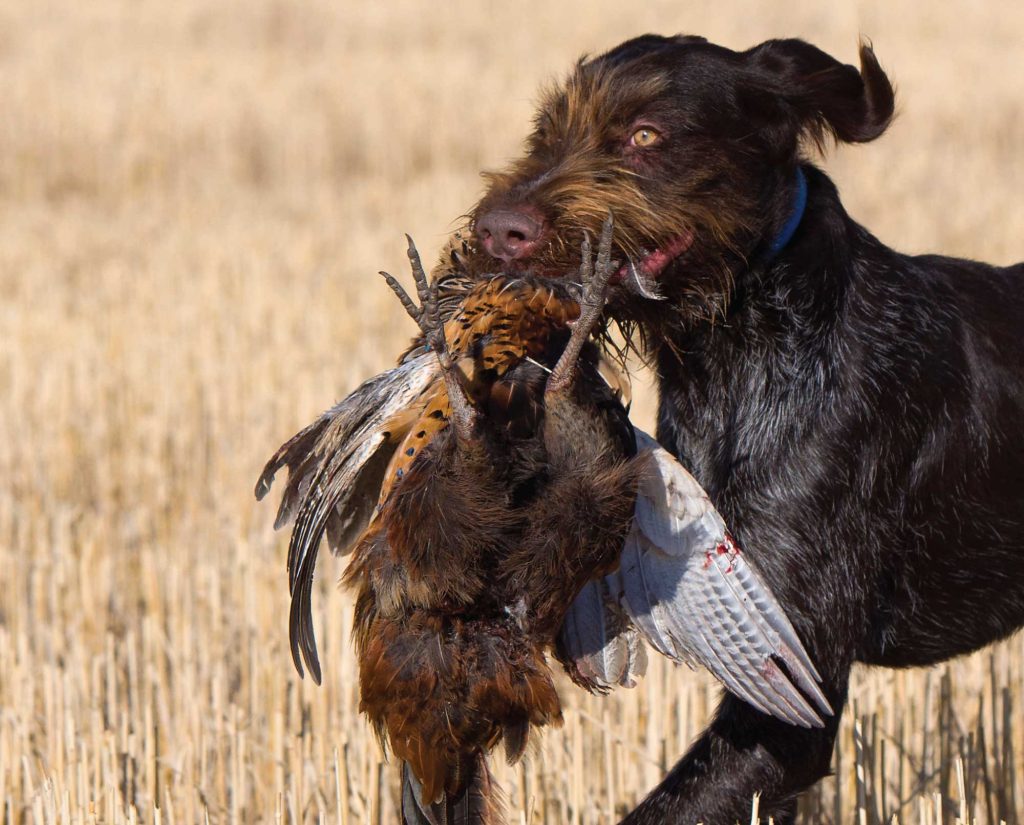
5. German Wirehaired Pointer (or Deutsch Drahthaar): 10%
The German dog popularity did not end with the GSP. German Wirehaired Pointers came in as the fifth most popular bird dog. If you want to start an internet war, much like the Silver Labs conversation, just mention the difference between the German Wirehaired Pointer and the Deutsch Drahthaar.
GWPs are the most popular among Millennials and Gen Xers. 10 percent of both generations own a Wirehair. They’re the second most popular among Boomers, of which nine percent hunt over one. GWPs and Drahts are the least popular among Gen Zers at just six percent.
In 2023 and 2024, GWPs were the 61st most popular breed in America, according to AKC data. It was the fourth most registered breed with NAVHDA in 2022.
46 percent of German Wirehaired Pointer owners hunted more than 30 days in 2024. During those days in the field, they chased pheasant (82%), ruffed grouse (46%), Huns (40%), and sharp-tailed grouse (38%).
The German Wirehaired Pointer is a latecomer to the United States. The official club was not formed until 1959. The first German club in the United States started in 1971, and by 1984, a Canadian chapter was also recognized by the VDD.

2025’s Above 1% Club, According to the North American Upland Bird Hunting Survey
Didn’t see your favorite breed in the top 5? Perhaps you’ll find it in our Above 1% Club. Here’s a breakdown of the dog breeds are owned by more than 1% of the community in 2025:
- Wirehaired Pointing Griffon (7.5%)
- Pointer (5.1%)
- Pudelpointer (5%)
- Small Munsterlander (4.1%)
- Springer Spaniel (3.6%)
- English Cocker (2.9%)
- Golden Retriever (2.5%)
- Vizsla (2.5%)
- Gordon Setter (2.1%)
- Boykin Spaniel (1.4%)
- Irish Setter (1.1%)
- Spinone Italiano (1.1%)
After the Irish Setter, the 13 other breeds we listed in our survey polled under one percent from there on out.
The wide variety of dog breeds found within the top 16 most popular bird dog breeds represents different styles and flavors of hunting birds over a dog. Flushing, pointing, and versatile dogs of all shapes, sizes, and forms are all present in the top five breeds and are found throughout the 16 most popular breeds.
As bird hunters, we’re fortunate to have the freedom to choose our breed of choice allows us to truly do things however we want. We’re incredibly grateful to all the dog-loving folks who have dedicated themselves to the preservation, proliferation, and continued future of these incredible hunting dog breeds.
The Most Uncommon Dog Breeds of 2024
Just because these pups aren’t owned by hundreds of folks in the Project Upland Community, that doesn’t diminish their worth whatsoever. In fact, their uncommonness speaks to the rarity of these breeds and the vast spectrum of bird dogs available for prospective bird dog owners.
If you’re looking to add an uncommon bird dog to your family, here are the least-owned hunting dog breeds of 2024:
- Wirehaired Vizsla (0.49%)
- Braque d’Auvergne (0.29%)
- American Cocker (0.10%)
- Blue Picardy Spaniel (0%)
- Braque du Bourbonnais (0%)
ICYMI: Previous Years’ Most Popular Dog Breeds
In case you missed it, the list of most popular bird dogs according to the North American Upland Bird Hunting Survey in years past:
| Breed | Percentage Owned in 2024 | Percentage Owned in 2023 |
| German Shorthaired Pointer or Deutsch Kurzhaar | 19.5% | 20.9% |
| Labrador Retriever | 16.8% | 18.7% |
| English Setter | 16.3% | 14% |
| Brittany | 13.2% | 11.4% |
| German Wirehaired Pointer or Deutsch Drahthaar | 9.6% | 10.7% |
| Wirehaired Pointing Griffon | 8.6% | 7.4% |
| Pointer | 7.1% | 4.8% |
| Pudelpointer | 5.8% | 5.2% |
| Springer Spaniel | 4.3% | 4.5% |
| English Cocker | 3.5% | 3.1% |
| Small Munsterlander | 3.3% | 3.3% |
| Gordon Setter | 2.5% | 1.9% |
| Golden Retriever | 1.8% | 2.9% |
| Boykin Spaniel | 1.7% | 1.6% |
| Vizsla | 1.7% | 2.2% |
| Irish Setter | 1.1% | Less than 1% |
| Weimaraner | Less than 1% | 1.4% |
As you can see, these breeds are recurring favorites with upland hunters. Whether you love versatile German breeds or water-obsessed Labradors, a wide variety of bird dogs make up our most popular list year after year.
Will this trend continue into 2025? Only time will tell…



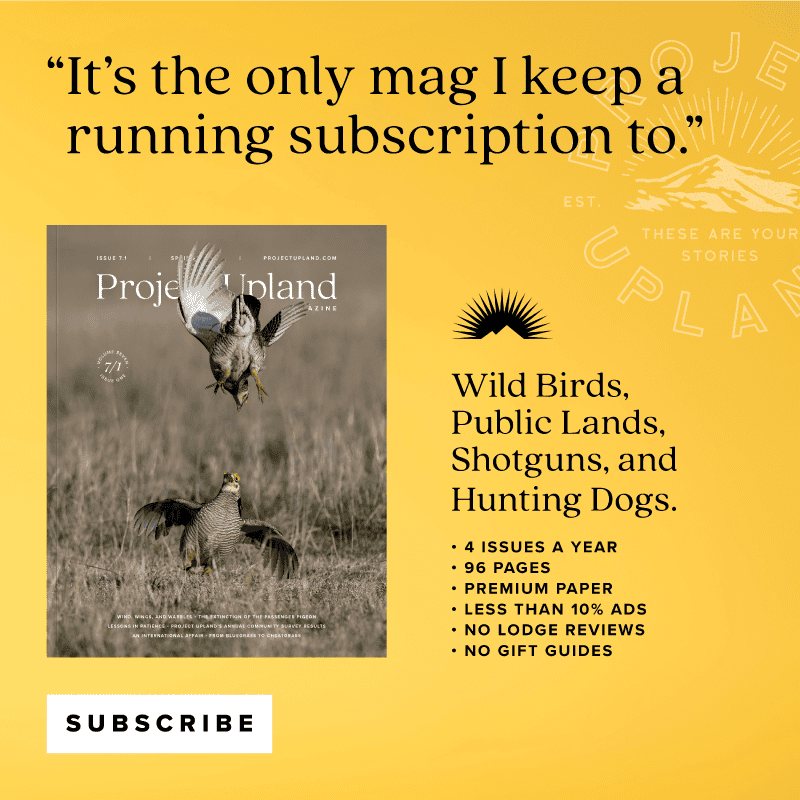
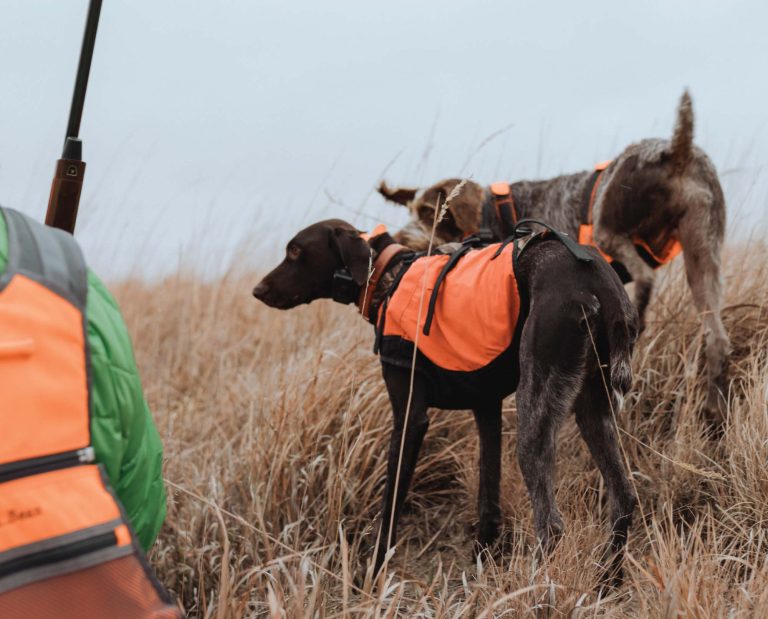
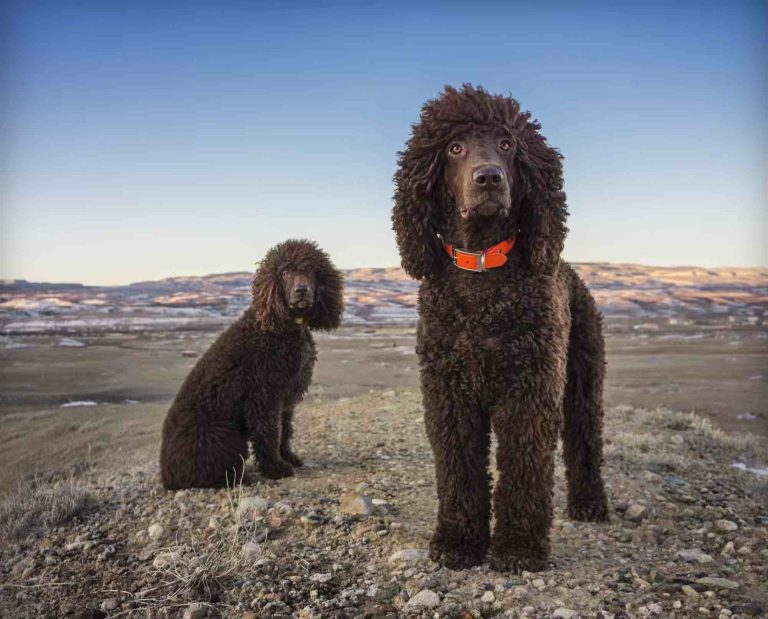

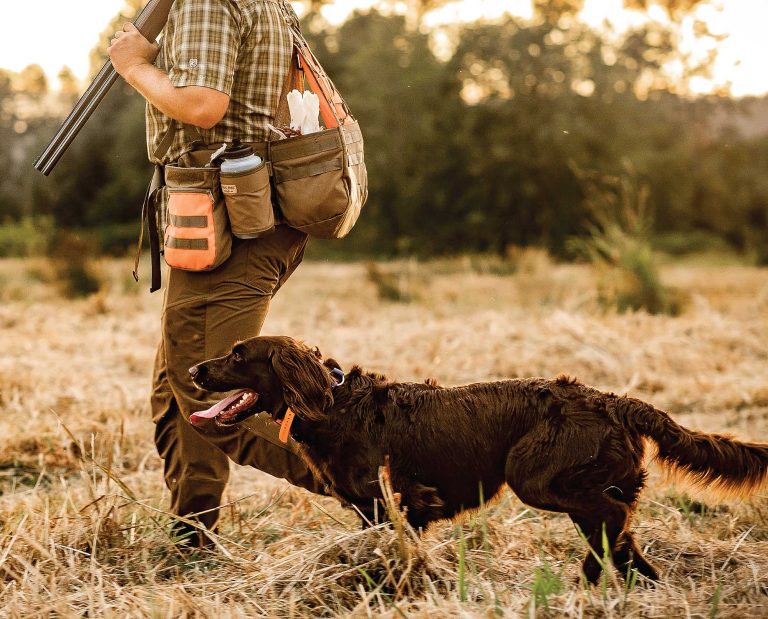
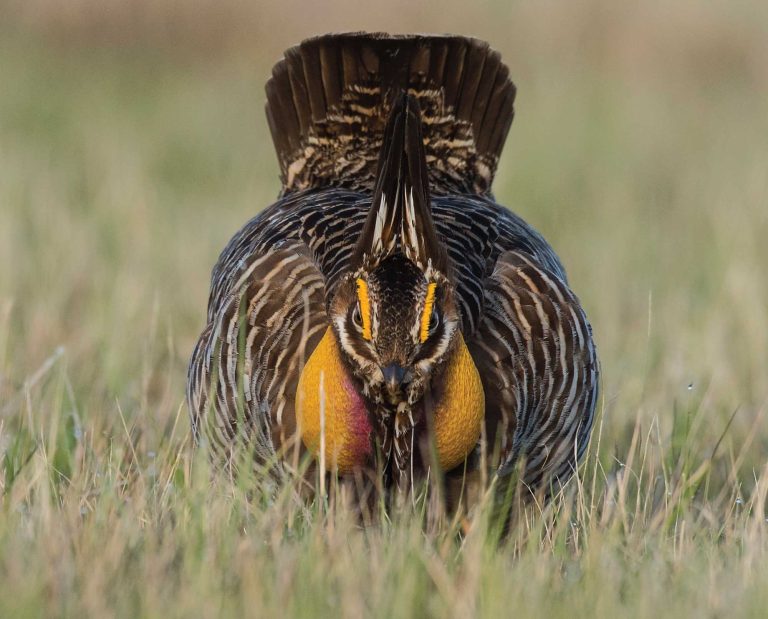
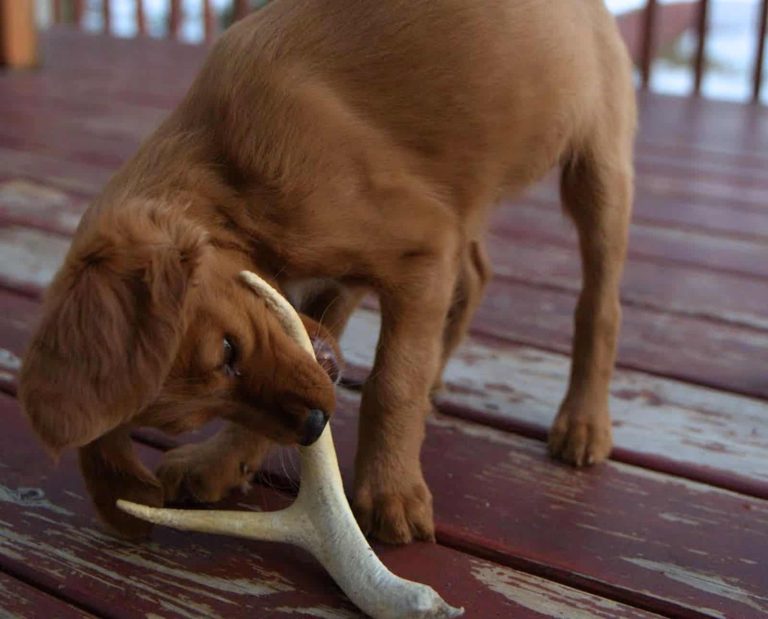
Interesting article. Please note: Drahthaar is misspelled! ” The English springer spaniel placed fifth place at 4.38 percent. The last five slots are held in the order of the wirehaired pointing griffon, drahtaar, vizsla, English pointer and the golden retriever. “
The author did not know there’s no “y” in Llewellin. Grouse hunters who own setters always refer to their dogs by their strain, i.e. Ryman, DeCoverly and Llewellin, hardly ever as English setters. They leave that for Field setter owners.
This was interesting. And of course the answer is correct as both my Llewelyn and I agree with the result I subscribe to Project Upland and have found the first couple of issues somewhat interesting. But I also have noticed what you commented on which is that a preponderance of your authors writing about grouse and western plains hunting. To hold me and guys like me in your audience you need to get some voices from the southeast. It’d be a natural, upland hunting for quail is in our blood here.
Cool article. We breed GSP’s and Brittany’s. I am liking this format. Just starting to explore PU now. Thanks
The last spot can’t be held by Golden Retriever. I hunt a couple of Braque Francais, and they have to be less numerous in the upland community then the Golden Retriever.
Brittanys and GWPs are clearly not the authors favorite breeds. Three short paragraphs and one photo each haha.
While I am not surprised the GSP is on the top it would be safe to speculate that the GSP as a name no longer describes one breed but rather a type of dogs that may share superficial similarities and some ancestry. There is enormous difference between the GSP that goes beyond mare line or subset within the breed. I don’t see anything in common between a 40lb quail dog and a 65Lb NAVHDA bred GSP. Not to mention the DK, which is almost its own breed, has got its own lines and types which vary by kennel or regions. I guess only common physical feature between these dogs is the docked tail.
This so called GSP dogs vary from the manner of hunting, style and temperament.
It is also safe to assume that the good percentage of the GSP in America has some doze of Pointer blood. However, this is not unique to the American GSP, but quite often happened in many other countries such as Italy, France and the Balkans.
But one thing is clear, the GSP is the most successful upland breed in the world. You will not find a country with an upland culture that does not have GSPs. And maybe their success lay in that they are very diverse, adaptable and flexible in a sense.
Based on this survey, I wonder what the ration between GSP and DK is? (Yes, I have a bias for DK though I don’t own one)
What is the exact difference between the English Pointer or a GSP? My Ben dog is registered GSP but I bought him as much for his resemblance to the English Pointer which We hunted as a youth (white w/ liver spots) as much as Ben’s close hunting instinct & retrieving/soft mouth instincts. Size/body weight?
it all depends on game being hunted.. if it were duck; retrievers, grouse/quail/pen raised pheasant; pointers.. wild pheasants; springers. there is no better breed than a springer for pheasant.. i would put a springer against any other breed w/ similar experience any time.. i especially love all the false points, the pointing breeds give.. lol… there is nothing better than watching a flusher pick up scent and chase it down until it flushes..
much like the argument chevy, ford or dodge
it depends on what you are hunting… ducks; retrievers, quail, grouse, pen raised pheasants; pointers, wild pheasants; springers.. there is no better breed. will take a springer head to head on any upland bird w/ similar experience.. nothing better than watching a springer flush a bird. my dad always said, pointers are a lazy mans hunting dog.. jk…
And where does the Irish Red & White Setter appear. Historically the beginning of the Irish Setter. They are far and above excellent bird dogs. Because of their scarcity no one seems to want to try and work with them.
This is categorically flawed. “Versatiles” are pointing breeds theoretically. So the first graph should combine pointing and Versatile data. Also “spaniel” isn’t an action category like Pointing dog, or retriever. The proper category would be “flusher”. If asked about ownership of a spaniel vs a flusher your data received would probably also look different. Good fun. Keep up the good work.
So what are the breeds ranked between number 16 and 26?
You listed 1-16 and 26-30.
Here you go:
Irish Setter: 1.08%
Braque Francais: 0.98%
Chesapeake Bay Retriever: 0.88%
Large Munsterlander: 0.79%
Spinone Italiano: 0.79%
Weimaraner: 0.69%
American Cocker: 0.59%
Bracco Italiano: 0.59%
German Longhaired Pointer (or Deutsch Langhaar): 0.59%
Cesky Fousek: 0.49%